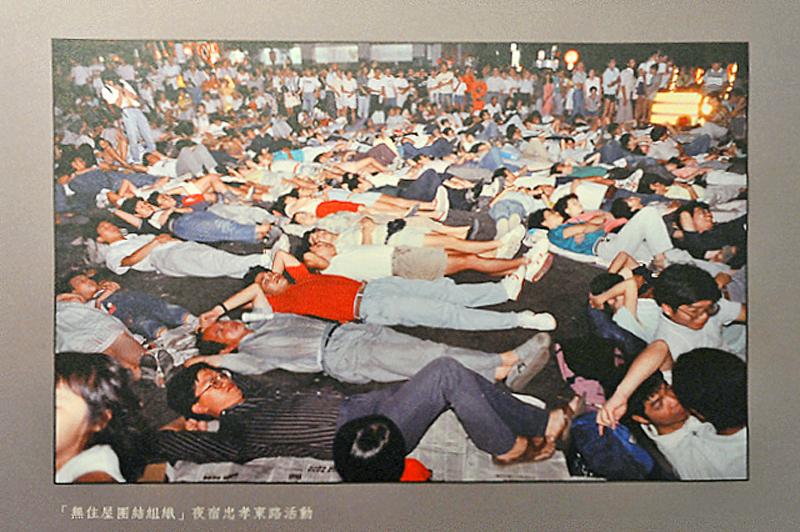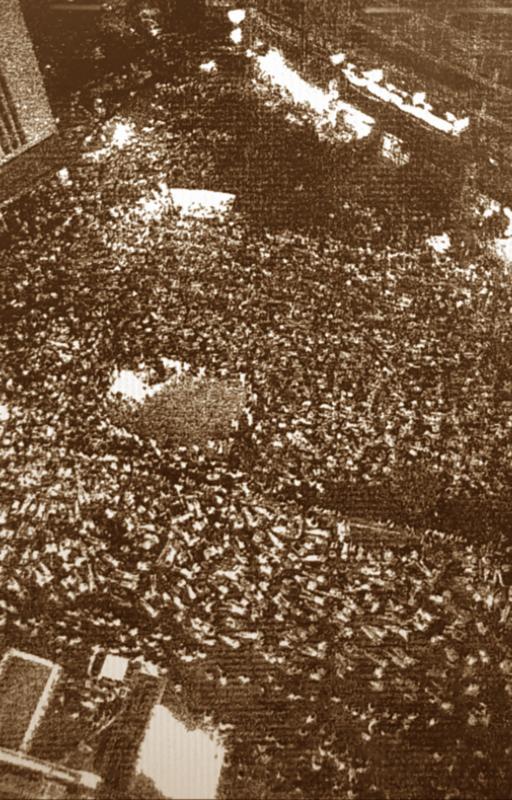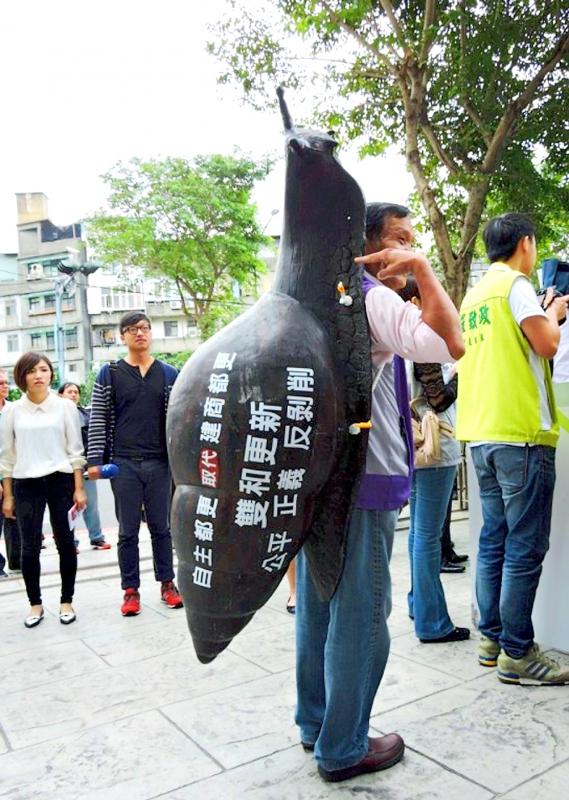Aug 24 to Aug 30
On the night of Aug. 26, 1989, an estimated 50,000 people laid down on straw mats in the middle of Zhongxiao E Road, the main throughway in Taipei’s bustling East District. It was the most expensive area in Taipei at that time, dubbed the “Golden Mile” (黃金地段) by the media.
Protesting the nation’s skyrocketing housing prices, groups put on performances such as a “Monopoly Dance” (referring to the board game) mocking land speculators and a play where a superhero defeats evil real estate price gougers. While many participants went home shortly after midnight, several hundred spent the night in front of Dinghao Plaza.

Photo courtesy of National Taiwan History Museum
“If we don’t own a home, the worst that can happen is we’ll sleep on the streets. Well, if we’re going to sleep on the streets, we’ll sleep on the most expensive street in the nation,” organizer Lee Hsing-chang (李幸長) told Commonwealth Magazine (天下).
A sleep-in took place at Zhongshan Park (today’s Taichung Park) as well, while groups in Taipei County (today’s New Taipei City) held a demonstration in front of the local government office in Banciao (板橋).
The protesters called themselves “snails without shells” (無殼蝸牛), which became a symbol for the battle against housing prices that is still used to this day. Unaffordable housing remains a serious issue, and in May of last year 250 protesters paid tribute to the original “snails” by taking turns sleeping in 50 tents in the East District for five straight days.

Photo: Shih Tsung-hui, Taipei Times
RISE OF THE SNAILS
Lee was a school teacher whose life was overturned at the end of 1988 when he sold his home. He had planned to switch to a smaller abode to save money, as he was preparing to pursue his master’s degree and expecting a child. But in six months, Taipei’s housing prices surged so much that he couldn’t even buy back his original home, which had nearly doubled in price.
The Commonwealth Magazine article states that in February 1987, Cathay Life Insurance paid NT$150 million — three times the market price — to purchase a piece of land on Nanjing E Road. This caused real estate prices around the property to surge as well, and eventually the prices rose exponentially across Taipei.

Photo: Ho Yu-hua, Taipei Times
Lee planned on just holding a press conference to air his grievances, but it unexpectedly attracted countless people who also suffered the same problem. In May 1989, he formed the “Homeless Help Association” (無住屋者救援會) and coined the term “snails without shells,” which became the name of the movement.
By July 9, the group had swelled to 2,000 members and took public action for the first time by wearing giant snail shells on their backs and handing out flyers at Taipei Main Station and other crowded areas of the nation’s capital.
“Owning a home should be a human right, housing prices are not stakes for corporations to play the money game,” they declared.
“Despite forming just two months earlier, the Homeless Help Association has grown at lightning speed and garnered a great deal of public attention,” the Liberty Times (Taipei Times’ sister newspaper) reported. “It’s undeniable that the real estate situation has become a serious social and economic problem.”
With the legislative and national assembly elections around the corner, the issue became a hot topic for politicians to win votes, further boosting the association’s profile.
Lee told the United Daily News (聯合報) that his life was thrown into disarray by his newfound fame, and he regretted launching the movement.
“But I won’t give up until housing prices go down,” he declared.
DENIED WEDDING GIFT
At the sleep-in demonstration, the Homeless Help Association made three requests to the government: Enact rent regulation legislation, establish vacancy and speculation taxes, and provide resources to help companies build employee housing.
Many legislators and city councilors showed up to support the protesters, but the Liberty Times notes that none of the invited officials showed up, such as then-interior minister Hsu Shui-teh (許水德) and then-deputy chief of the Council for Economic Planning and Development Vincent Siew (蕭萬長).
At 5am, those who actually spent the night cleaned up the area and left. The media praised the movement for its peaceful, humorous and responsible behavior.
After several meetings with the government, the association formed the Organization of Urban Re-s (專業者都市改革組織), enlisting architects, urban planners and housing experts to brainstorm feasible plans to ameliorate the situation.
On Sept. 24, the association held its second major sleep-in, camping outside Cathay Life Insurance headquarters for three days. At the conclusion of the protest, participants threw black gloves into the sky to denounce the corporation’s actions.
Afterward, they held a mass wedding of homeless couples at Chiang Kai-shek Memorial Hall, requesting Cathay Life Insurance to provide a guarantee that they would stop gouging housing prices as a wedding gift. Cathay’s officials ignored the protesters during the whole event.
Among those who participated in the wedding was Tsuei-Chen Shui-chin (崔陳水金), who was suffering from terminal cancer and arrived in her wedding dress in a wheelchair. She became acquainted with the association through her daughter, and she and her husband provided them much support. Tsui-Chien died two days later, and the association founded the Tsuei Ma Ma Rental Center (崔媽媽租屋中心) in her honor. The service is still popular today.
“Besides inventing the term ‘snails without shells,’ I feel like the movement achieved nothing besides depleting me of all my resources,” Lee laments in his 2015 memoir. “But although I complain, I don’t regret it. Real estate prices are still so high that the regular office worker can never imagine owning a home one day. I can only keep telling myself, ‘I must insist on my ideals, and I believe there will eventually be justice.”
Taiwan in Time, a column about Taiwan’s history that is published every Sunday, spotlights important or interesting events around the nation that either have anniversaries this week or are tied to current events.

Nine Taiwanese nervously stand on an observation platform at Tokyo’s Haneda International Airport. It’s 9:20am on March 27, 1968, and they are awaiting the arrival of Liu Wen-ching (柳文卿), who is about to be deported back to Taiwan where he faces possible execution for his independence activities. As he is removed from a minibus, a tenth activist, Dai Tian-chao (戴天昭), jumps out of his hiding place and attacks the immigration officials — the nine other activists in tow — while urging Liu to make a run for it. But he’s pinned to the ground. Amid the commotion, Liu tries to

The slashing of the government’s proposed budget by the two China-aligned parties in the legislature, the Chinese Nationalist Party (KMT) and Taiwan People’s Party (TPP), has apparently resulted in blowback from the US. On the recent junket to US President Donald Trump’s inauguration, KMT legislators reported that they were confronted by US officials and congressmen angered at the cuts to the defense budget. The United Daily News (UDN), the longtime KMT party paper, now KMT-aligned media, responded to US anger by blaming the foreign media. Its regular column, the Cold Eye Collection (冷眼集), attacked the international media last month in

Feb. 10 to Feb. 16 More than three decades after penning the iconic High Green Mountains (高山青), a frail Teng Yu-ping (鄧禹平) finally visited the verdant peaks and blue streams of Alishan described in the lyrics. Often mistaken as an indigenous folk song, it was actually created in 1949 by Chinese filmmakers while shooting a scene for the movie Happenings in Alishan (阿里山風雲) in Taipei’s Beitou District (北投), recounts director Chang Ying (張英) in the 1999 book, Chang Ying’s Contributions to Taiwanese Cinema and Theater (打鑼三響包得行: 張英對台灣影劇的貢獻). The team was meant to return to China after filming, but

On a misty evening in August 1990, two men hiking on the moors surrounding Calvine, a pretty hamlet in Perth and Kinross, claimed to have seen a giant diamond-shaped aircraft flying above them. It apparently had no clear means of propulsion and left no smoke plume; it was silent and static, as if frozen in time. Terrified, they hit the ground and scrambled for cover behind a tree. Then a Harrier fighter jet roared into view, circling the diamond as if sizing it up for a scuffle. One of the men snapped a series of photographs just before the bizarre